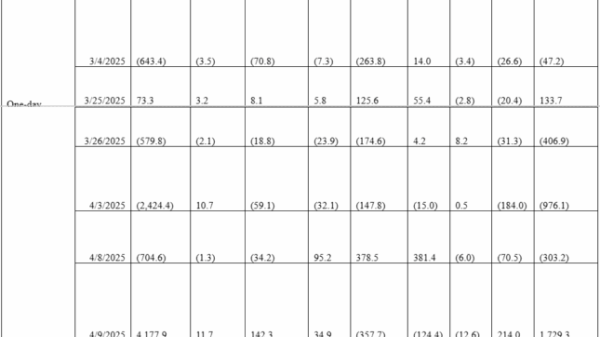In its first hundred days, the second Trump administration has been anything but usual by presidential standards. From trade wars to an assault on the federal bureaucracy, Trump and his team have swiftly reshaped the landscape of government action. Amid the torrent of daily news, some critical policy discussions have been swiftly overlooked.
One such overlooked comment came from Commerce Secretary Howard Lutnick who argued in an interview that the official GDP measure should exclude government spending. Economists immediately pointed to the dangers of trying to replace such a widely used economic statistic. However, as we argue in a forthcoming article in the Review of Austrian Economics, there is a case for complementing the existing statistic with alternative measures that exclude at least some components of government spending. After all, it is true that government spending can distort our understanding of economic well-being — a concern that deserves serious consideration. So much so that it alters key facts of American economic history.
The commonly known GDP statistic is a simple sum: consumption spending, investment spending, government spending, and net exports (which is spending by foreigners). Government spending in this equation captures government activity such as the hiring of people to work in a new government office or the purchase of uniforms for soldiers.
This somewhat clashes with the formal definition of GDP: the market value of final goods and services. This reveals a conceptual problem as many government goods and services, such as military equipment and bureaucratic administration, aren’t sold in competitive markets. Without genuine market prices, their value is approximated by government spending costs. But the cost says nothing about “value.” After all, the government could hire a million persons to dig holes and fill them back up. No value is created but costs are incurred.
Historically, even Nobel-winning Simon Kuznets, who pioneered national income accounting, expressed major concerns about this issue. He suggested instead that such expenditures might be better understood as intermediate goods, already accounted for in private-sector production. Another Nobel laureate, James Buchanan, argued for something similar.
Such lines of reasoning influenced more radical economists like Murray Rothbard, who proposed entirely removing government expenditures from GDP. Rothbard’s “Private Product Remaining,” for example, excludes government spending and taxation entirely.
While most economists view this approach as overly extreme, there is an easy “midway” consensual measure we can construct. Following economic historians Robert Higgs, Lowell Gallaway and Richard Vedder, we exclude military spending and adjust price indexes during periods of price control.
This is because military expenditures on weapons and war materials do not directly translate into better material living standards for civilians. Defense spending should be excluded from GDP when assessing living standards because military goods — like tanks, bombs, and bullets — do not directly contribute to civilian welfare. They are not consumed by households, nor do they improve the quality of everyday life. Including them inflates measures of prosperity in ways that misrepresent how ordinary people are actually doing. Moreover, a great deal of government expenditures during wars represent coerced production (e.g., drafts, requisitions, seizures, nationalizations) which make it harder to evaluate the value to civilians. Finally, during conflicts, governments impose price controls which hide the true extent of inflation.
Removing the effect of price controls and defense spending, what we dub the Defense-Adjusted National Accounts, provides a clearer picture of civilian living standards uninflated by defense expenditures and artificially suppressed wartime prices.
Of course, these corrections reduce the level of the GDP statistic. But that is not all it does. The corrections produce a new series that alters our understanding of US economic history during various periods. The most obvious, and previously covered by Robert Higgs, is during World War II. The official GDP statistics show an economy growing rapidly, which led many to consider the war effort as key to finally ending the Great Depression. Our corrections, and Higgs’s before ours, clearly show that the economy was declining. That is, for the average consumer things in the US were getting worse, not better, during the war.
In fact, our corrections applied to the entire period from 1790 to today show new key facts. Our corrected GDP series reveals that the first half of the 20th century, rather than showcasing robust growth, emerges as a prolonged period of stagnation interrupted by crises. The economy, which had grown at an exceptional pace from 1865 to 1913, gradually deviated from this path between 1913 and 1950. Many claim that this deviation only occurred during the Great Depression and that it ended during the Thirty Glorious years after. But our corrected series show that America never returned to its exceptional growth path.
Finally, pairing our corrected GDP with historical income distribution (i.e., inequality) data reshapes the narrative of the “Great Leveling” during the mid-twentieth century and particularly during wartime years. The leveling, traditionally celebrated as a period of diminishing inequality, actually coincided with declining living standards for everyone — even the wealthy.
Why does this matter today? Current discussions of economic policy often rely on GDP as the key indicator of economic well-being. Yet many Americans feel a significant disconnect between reported economic statistics and their own experiences — the so-called “vibecession.” By acknowledging that traditional GDP figures might inflate government activity’s real contribution, especially military spending, we can better align statistical measures with genuine economic conditions experienced by everyday citizens.
As policymakers grapple with budget priorities, military spending, and public perceptions of economic health, a more accurate measurement of living standards is essential. Adjusting GDP to focus explicitly on private-sector prosperity clarifies whether government actions genuinely contribute to citizen well-being or merely inflate an imperfect statistical measure.
We don’t advocate replacing standard GDP as it captures an approximation of the true statement that not all government expenditures are without value. However, adopting a Defense-Adjusted National Accounts measure can help provide another approximation of a true statement: that wars do not improve living standards. These two approximations together help provide a smaller window for uncertainty. This can help bridge the gap between official economic data and the perceptions of the American public.













